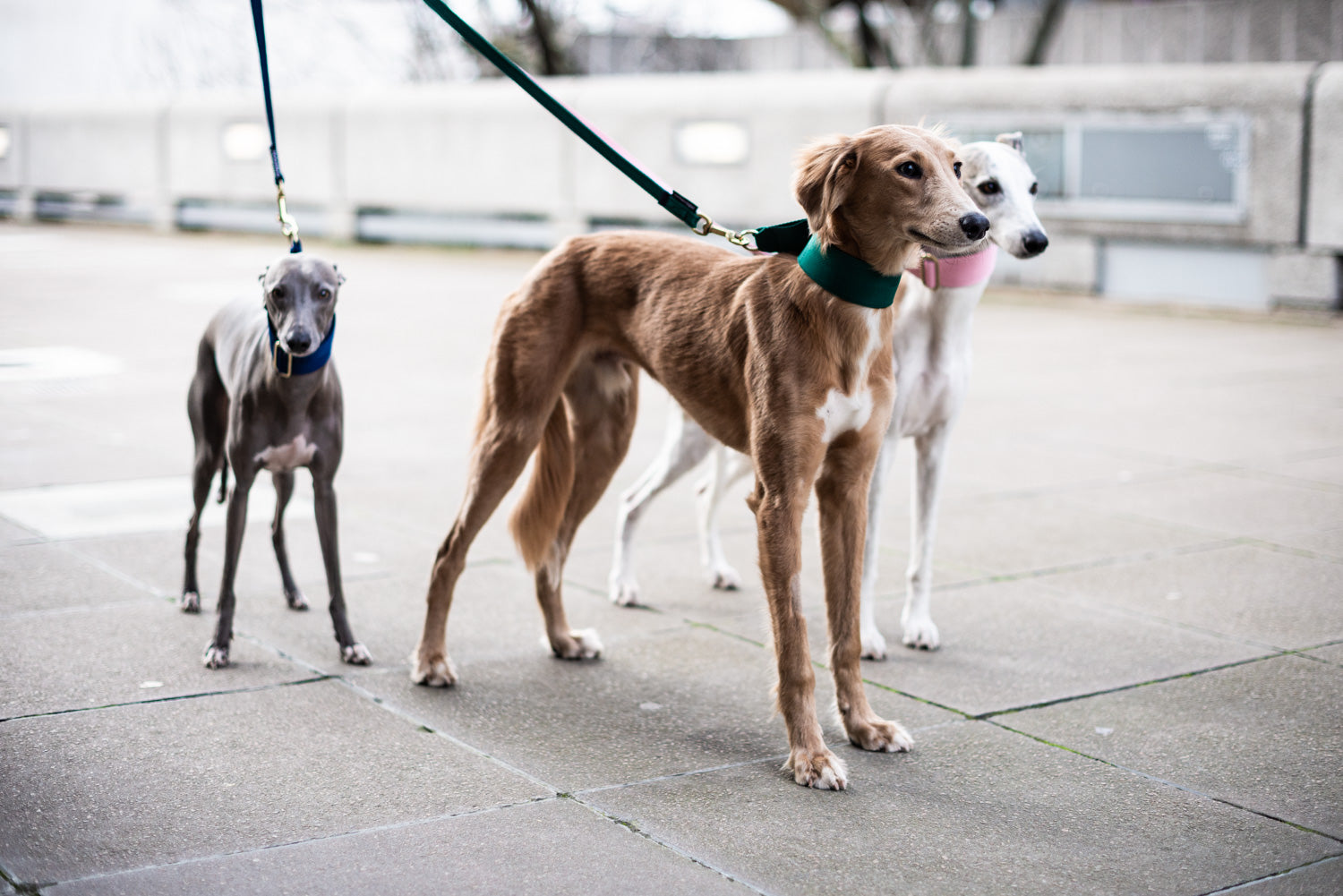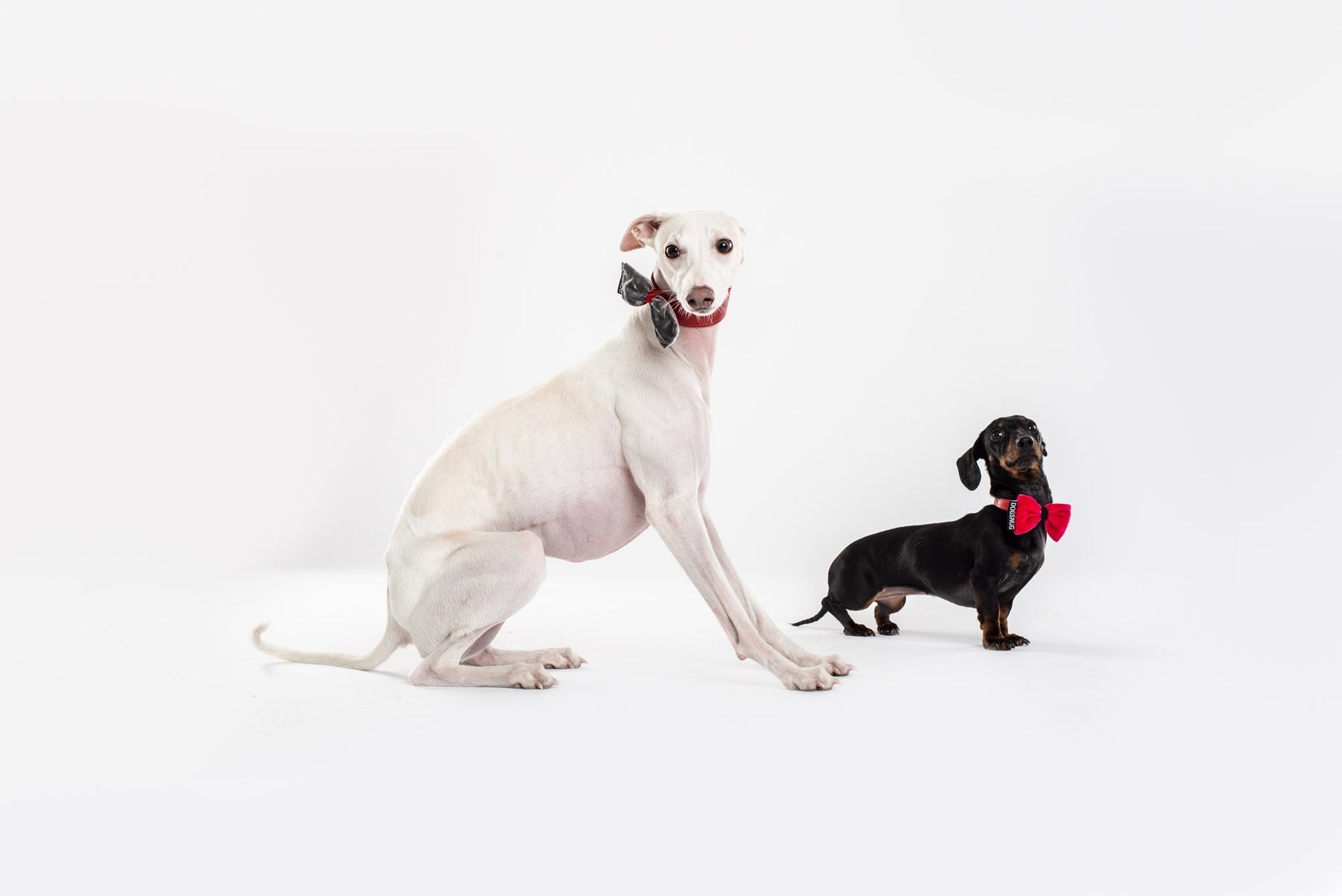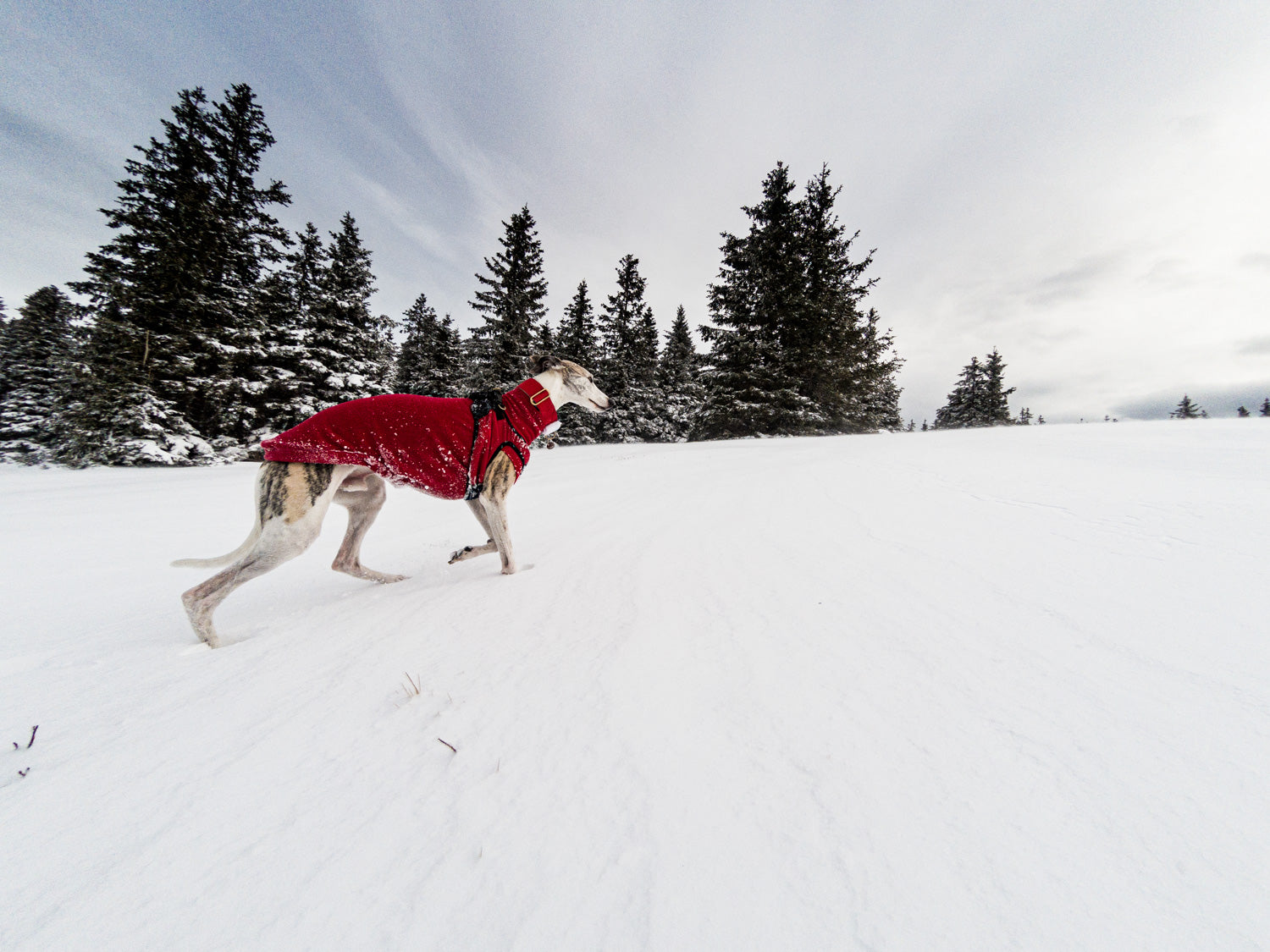8 AUTUMN TIPS TO KEEP YOUR DOG SAFE AND HEALTHY
Autumn is in the air, and although this is a wonderful magical season it can also pose many challenges to keep our dogs safe and healthy: from poisonous threats to keeping visible. If you want to know if your dog needs a coat and what you can do to keep your beloved hound safe and sound this fall, keep reading.
1. WHY YOU SHOULD KEEP THE MUD OFF YOUR DOG

As a dog guardian, a big challenge in autumn is to keep our dogs mud-free. And does anyone know of a dog that does not love a good mud bath, specially if her/his dog guardians have just dished out on a trip to the groomers? With the autumn season, as we get more rainy days, our parks and fields often get water-logged, making a fun time for the dog, but a frantic mess of us humans as we attempt to distract and deter our happy hounds from jumping all four legs into the muddy patch.
No matter what you do, always make sure that you clean off the mud from your dog, as staying muddy can bring a number of health issues for your dog, from minor ones to more serious, life threatening ones:
Seasonal Canine Illness: (SCI):
According to the Animal Health Trust (AHT), this mysterious autumn illness is prominent between August and November and any dog of any breed can catch in any woodland in the UK. The symptoms include vomits, diarrhoea and lethargy and will be experienced within 72 hours of walking in the woods. If you spot any of these symptoms make sure you contact your vet straight away as it can be very severe and life threatening. For more information visit the page.
Itchiness and Rashes
If the mud dries in the dog’s skin and fur, it can make your dog itchy and uncomfortable. Even though this is in no way life threatening, it can be really irritating.
Cleaning your dog does not need to involve shampoos or other cleaning products, usually water and a dry towel is all you need to clean the mud off. And in fact, it is a good idea not to use cleaning products on your dog too often as this can wash off their natural skin oils necessary for a healthy coat.
2. SHOULD I LET MY DOG PLAY WITH CONKERS? …AND OTHER POISONS
Conkers, Oaks and Acorns
Our Kai loves playing with conkers, and being a mischievous Whippet, he has learned to hide it in his mouth and to pretend he has nothing. We have had to develop a 6th sense to spot when he’s got one, as we have learnt that conkers, oaks and Acorns can cause all sorts of problems if ingested, from intestinal blockages, damage to the liver and kidneys and/or mild poisoning.
Rat & Vermin Poisons
During the autumn wild life starts to prepare for the winter, and to secure survival: having enough food and warmth. More people notice the unwanted squatters moving in during this time of year, and more poisoned baits are laid. Even though manufacturers claim that these poisons are not harmful to pets, there is anecdotal evidence that such baits can interfere with the blood clotting and cause haemorrhage in some dogs, which will need veterinary treatment.
Antifreeze
Awful thing for dogs! But as the days get colder, more people need to use it in their cars, and sometimes it spills or leaks. Antifreeze contains Ethylene Glycol, and can be lethal to dogs if not treated urgently. If your dog looks ‘drunk’ and you are concerned that it may have ingested antifreeze, contact your vet straight away.
Chocolate
Trick or Treat anyone? During Halloween there is a lot of chocolate around. How is it possible that something so delicious and perfect for humans can be so harmful to dogs? And yet, unfortunately that is the sad truth. You have probably heard by now, but chocolate contains theobromine which is highly poisonous for dogs: it will affect their hearts, central nervous system and kidneys and can be life threatening. The PDSA advices contacting your vet without delay if you suspect chocolate poisoning. More information on Chocolate poisoning can be found in their page.
Mushrooms, Toadstools
During the humid months of the fall, there are many more mushrooms and other vegetation that thrives from moist. Although very beautiful, some can be highly toxic for dogs.
3. LETS KEEP PHYSICAL, PHYSICAL…

We get it: it’s dark, it’s raining and the wind is not letting you think. But don’t forget that some daily exercise is very important to keep a healthy body, not just for your dog, also for you.
All dogs are different, some need a gentle walk, some a good old zoom-out, and others need herding or at least a simulation of ‘work’. This depends on the breeds they’re made of, their size, age and health status. But they all need at least 30 minutes of exercise a day.
Going out with your dog does not need to be a constant walking or running, in fact many dog behaviourists suggest that as part of the daily walk we should mix in some games and training to keep your dog well trained and focused.
Here are some benefits of exercising every day:
Strengthens the Immune System
Going out every day helps the immune system to stay strong; and help fight bugs away.
Keeps your Dog Regular
Exercise helps to reduce digestive problems and constipation.
A Healthy Body, A Healthy Mind
Dogs, like humans, need mental stimulation. Walking, running, chasing the ball or even interacting with the environment and other beings keeps your dog stimulated and helps to reduce behaviour problems such as digging, chewing and hyperactivity. A good walk will help them relax when it’s time to settle back on the couch and, in the case of Kai, under a cozy blanket.
Keeps them Agile and Supple
What you don’t use, you lose. Having healthy joints depends greatly on keeping moving, even for the seniors out there.
4. NOW YOU SEE ME, NOW YOU DON’T
 Kai the Whippet is wearing a Dogsnug Reflective Bandana
Kai the Whippet is wearing a Dogsnug Reflective Bandana
The days are getting shorter and the nights are getting longer. This means that we’re often walking our dogs in the night or in low light conditions. If you walk your dog off lead or if you walk near traffic, it’s a good idea to be able to see your dog and be seeing by other road users. It is worth considering using accessories with the following technologies:
High Visibility
This is kind of gear that let’s you be seen even during the day, usually made of fluorescent colours like Orange, Yellow and Pink. As the sun shines on these colours, it makes them glow and therefore increases daytime visibility. They are excellent when the light is poor or if its foggy.
Reflective
the kind of material that seems to ‘light up’ when a torch or light is shown towards it, for example, car lights. Reflective materials are usually composed of tiny glass particles or prismatic reflectors that in essence reflect the light back.
These days there is a great variety of products available in the market such as harnesses, coats, collars and leads.
5. DOES MY DOG NEED A COAT?
 Oscar the Boston Terrier is wearing a Dogsnug Water Repellent Jumper
Oscar the Boston Terrier is wearing a Dogsnug Water Repellent Jumper
Colder temperatures and rainier days are always the way with Autumn. And so we wonder, does my dog need a coat to protect her/him from the elements? And how cold and/or wet does it need to be.
The decision to add a coat to our dogs depend on many factors, how long and dense is their fur, how cold is it, what breed or mixture of breeds is your dog, what is their health condition, how big is your dog, how old is it?
So for example, Huskys and Akitas are built by nature to withstand much lower temperatures and rain, as they have dense undercoats and harsh outer coats and so in fact giving them an extra layer of warmth might even be detrimental to their health; but a Chihuahua or a Whippet would be hypothermic when exposed to the same conditions.
According to vets, a healthy, comfortable internal temperature for a dog is 38º-39ºC. So if it’s cold outside and your dog has a short coat, or is small, low and close to the ground or has any health issues such as arthritis or heart disease, adding an extra layer of warmth will help regulate their internal temperature and it is probably a good idea.
If your dog is shaking and shivering, hesitant to go outside and it’s showing any signs of illness, then it is probably needing an accessory to keep warm.
Most experts agree that the following breeds would definitely benefit from some form of protection when it gets wet or temperature drop:
Skinnies
Dogs such as Greyhounds, Whippets, Italian Greyhounds seem to feel the cold and the rain more than many. This is because they have a short and light fur, very thin skin and hardly any body fat. Also some areas of their bodies (the chest for example) is often bold.
Hence the cold get into their bodies and organs really fast. If you’ve ever met one of these dogs you would know that getting them out on a cold or wet day is an accomplishment in itself. Our Kai gives us the dirty look and refuses to walk unless he’s well layered.
Low and Close to The Ground
Those cute Dachshunds really feel it too! Not only do they have short hair, their bellies are so close to the ground it is no wonder they get chilly very quickly. Our friend Ethel the Dachshund could leave attached to the radiator if she could all year round!
Short Haired and from Warmer Climates
Many breeds have been bred to live in warmer climates, for example Basenjis andSalukis, whilst other big and mighty like the Dobermans, Vizslas and Pointers simply seem to hate the cold.
Small and Mighty
Breeds like Chihuahuas and Chinese Crested, Miniature Pinschers andYorkshire Terriers although sometimes with long hair, have a thin coat and little body fat that makes them vulnerable to cold temperatures.
Dog warm clothing come in many shapes, weights and materials: from polar fleece to windbreakers. It is possible also to layer up as the temperatures drop and many people chose to have a light rain coat that can be used just for rain and to layer inside with jumpers and hoodies.
At Dogsnug we make a variety of breed specific jumpers, coats and winter harness to suit all your dog’s needs.
7. BOOM! CRACKLE! BAAA! OH THE JOYS OF HALLOWEEN & GUY FOLK NIGHTS
Bonfires, Fireworks, Sweets and Costumes, what’s not to love? Unfortunately this can be a trying time for dogs and their guardians.
Fireworks and what can help
Many dogs are petrified of fireworks, and if spooked enough, might erratically run off to get away from it all. It is a natural instinct for a dog to be scared of loud noises and fireworks. Let’s get in our dog’s four paws for a minute, if you heard a rumbling coming from close to the ground followed by the smell of burning and flashes, would you be worried? Now we get it!
The best way to deal with fireworks is to get your dog acclimatised to the experience. You can play a recording of fireworks every day for a number of weeks.Slowly raise the volume ever so slightly every day and make sure that you keep calm and serene whilst you are playing the sound. This worked for us really well, and we can even go to a firework display with Kai without any sign of distress from his part.
For some dogs this may not work, in which case taking the dog to a quieter place and giving cues of being calm whilst the fireworks take place may be the way to deal with this issue.
Costumes
The RSPCA has warned that dressing up dogs in costumes can make them feel scared, confused and unable to communicate with us and other animals. They rely on their ears, tails, eyes and body language to communicate, so if the costumes are impeding movement or expression, it can have a significant effect on their behaviour, particularly if they are already reactive to the fireworks. Use common sense when being festive, you can make your dog look quite festive without making their lives difficult.
Chocolates
See Section 2 on poisons for information on why Chocolate is a bad idea for your dog.
8. TAG!

Last but not least, it would be devastating to lose your very loved 4 legged companion. We would not dream of not having our dog microchipped, but have also seen first hand how very important it can be to have an ID tag with your contact details attached to your dog’s collar. Think about it, it is much easier and quicker to give you a call if your dog is found alone, consider that some people may be too much in a hurry or concerned about their own safety to take the dog to the vet, but most people would happily ring a telephone number to let you know they have found your dog.
We would love to hear if you have any other tips that you would want to share with us. Meanwhile we wish you a joyful, safe and adventurous Autumn : )
Dogsnug designs and makes a range of Water Repellent, High Visibility and Reflective Dog Accessories. Visit our online shop to view the whole range.





